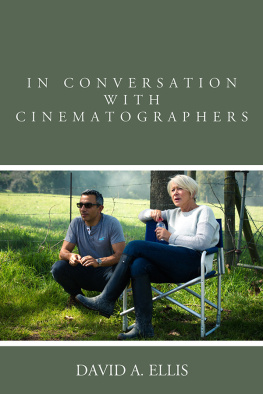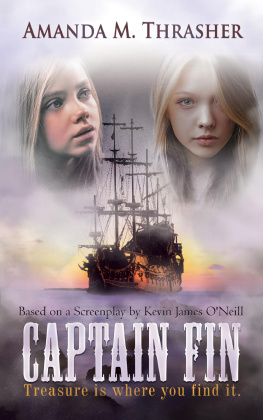In Conversation with Cinematographers
In Conversation with Cinematographers
David A. Ellis
Rowman & Littlefield
Lanham Boulder New York London
Published by Rowman & Littlefield
A wholly owned subsidiary of The Rowman & Littlefield Publishing Group, Inc.
4501 Forbes Boulevard, Suite 200, Lanham, Maryland 20706
www.rowman.com
Unit A, Whitacre Mews, 26-34 Stannary Street, London SE11 4AB
Copyright 2015 by Rowman & Littlefield
All rights reserved . No part of this book may be reproduced in any form or by any electronic or mechanical means, including information storage and retrieval systems, without written permission from the publisher, except by a reviewer who may quote passages in a review.
British Library Cataloguing in Publication Information Available
Library of Congress Cataloging-in-Publication Data
Ellis, David A., 1947
In conversation with cinematographers / David A. Ellis.
pages cm
Includes index.
ISBN 978-1-4422-5109-0 (cloth : alk. paper) ISBN 978-1-4422-5110-6 (ebook) 1. CinematographersGreat BritainInterviews. I. Title.
TR849.A1E55 2015
777'.8dc23 2015011564
 The paper used in this publication meets the minimum requirements of American National Standard for Information SciencesPermanence of Paper for Printed Library Materials, ANSI/NISO Z39.48-1992.
The paper used in this publication meets the minimum requirements of American National Standard for Information SciencesPermanence of Paper for Printed Library Materials, ANSI/NISO Z39.48-1992.
Printed in the United States of America
To my wonderful wife, Margaret;
my late caring father, John Arthur Ellis;
my late caring aunts, Violet Dimeloe and Florence Ellis;
my uncles, Samuel Dimeloe, Jonathan Ellis, and Alfred Ellis;
my two stepchildren, Nicky and Tracy;
and my two grandchildren, Chloe and James
Foreword
Sir Sydney Samuelson CBE, BSC Hon. Fellow BKSTS
Ingmar Bergman once said about cinema, No art passes our conscience in the way film does, and goes to our feelings, deep down into the dark rooms of our souls.
David A. Ellis has brought us a second collection of interviews with back room technicians, those senior showbiz folk whose talent, experience, and understanding make such a contribution to how a movie, every movie, looks when it is up there on the screen. They get none of the press and public attention of the front-of-camera glitterati, but the skill and the art of cinematographers are absolutely vital to the creation of atmosphere and the emotion triggering images experienced by audiences. The people included in this book are all differenttheir backgrounds, personalities, and the influences that remain with them from the demands of directors of movies they have previously photographed. As you read through the book you will come to realise that DPs (directors of photography) are all one offs. Producers and directors recruit their cameramen and their crewmembers very carefully. These days they already know well the photographic style of each candidate via DVDs of his/her previous work. But there is more to it than that; a senior technicians attitude towards others during production, the ability to get on with colleagues of both sides of the camera is also important, especially at times when a shoot is not going well. A DP with tact, understanding, and a degree of common sense can be a veritable peace broker, a tower of strength to all concerned at times of stress.
The average film production camera department is not famous for the creation of tabloid headlines of scandalous behaviour. Nevertheless, one of the fascinations of this book is the insight the reader gets about problems, pending technical disasters, and personality clashes that have to be addressed and solved with minimum time loss. David A. Elliss subjects explain the challenges that occur and how they are overcomehopefully without too much fuss.
In this interesting collection, you will not find a chapter headed How to Light the Set; it is not that kind of book. But you will gain insight into the many tasks and problems, big ones and insignificant ones, which beset all directors of photography working to budgets large and small.
My personal favourite story (not in the book) is recalling the trickiest of cameramens challengeswhen they must do their best, their most careful lighting for actresses who are no longer enjoying the facial glamour of their youth. Bette Davis, when a young actress in one of her earliest Warner Bros. films ( Jezebel 1938) was photographed by legendary Hollywood cameraman Ernest Haller ASC and she won an Oscar for her performance. Twenty-five years later, when they were both no longer under contract to Warners, by a strange coincidence they found themselves working together again, but on a small independent film. After viewing the first days rushes, Bette rushed out of the studio theatre and screamed at her cameraman, Ernie, what happened to you, I look terrible! Ernie replied, Bette, I got older. This is a book for thinking cinema buffs, those who want to know more about the fascinating technical side of making a movie.
For me, the pleasure of reading this book relates not to an endless mass of technical information on how this insolvable cinematographers problem was solved, and how the currently active pre-production discussionshoot on digital or stick to film with its still (some say) unmatchable lookwas aired and decided upon, not always by unanimous agreement. Rather we have here a compilation of behind the camera upheavals, experiences pleasant and difficult, and unexpected human behaviour.
So this is a book about a special group of techniciansamong the most creative in film and television. One reason why I think it is a bit different from many of the books published on cameramens lives over the years, from time to time, is this fascinating read even recalls the scuttlebutt and professional jealousy that exists between one cameraman and another, usually expressed among crew folk over a pint at lunch time.
But my eyebrows were certainly raised in this respect (although it is not in the book) by one of our absolutely greatest cameramen, speaking of another equally great, double Oscar winning expert in colour, in its earliest days. This DP was very publicity conscious; he made sure the press heard of his various achievements. About him, the other great cinematographer (only one Oscar, but four BAFTAs), expressed his personal opinion with But do you know, Sydney, he has never, ever shot a black and white film. He would be completely lost if faced with monochrome negative running through his camera machine.
Acknowledgments
Thanks go to Chloe Greensmith; James Greensmith; Robin Vidgeon; Ronnie Prince, editor of British Cinematographer magazine; Frances Russell from the British Society of Cinematographers; Lara Graham, associate editor at Rowman & Littlefield; my editor Stephen Ryan; and Mark Martin for the cover picture.
Introduction
In this volume we have twenty-three filmmakers relating their time in an industry they all love. Filmmaking is an addictive occupation and all the cinematographers I have spoken to are eager to carry on, even well past retirement age. They simply adore the business and look on it more as a paying hobby than an occupation. Some are not happy about the digital revolution and would prefer to stick with film. They are all happy to be still involved with story telling and the creativity that will always be there, no matter what advances are made technologically.
CHAPTER 1
Sue Gibson, BSC
(1952 )
Sue Gibson studied film at the National Film and Television School. She was the first woman cinematographer to become a member of the British Society of Cinematographers (BSC) in 1992. She joined the board in 2003 and became President from 20082010. She has worked on many commercials, shot TV drama, and worked on feature films. In 2005 she was given the Women in Film Contribution to the Medium Award.
Next page








 The paper used in this publication meets the minimum requirements of American National Standard for Information SciencesPermanence of Paper for Printed Library Materials, ANSI/NISO Z39.48-1992.
The paper used in this publication meets the minimum requirements of American National Standard for Information SciencesPermanence of Paper for Printed Library Materials, ANSI/NISO Z39.48-1992.